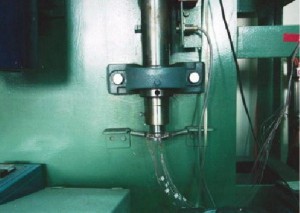The experimental setup and details for temperature measurement are shown in the picture, respectively. The facility is mainly comprised of a heated section, compressor, a motor, a heat source, two slip ring assemblies, and a data logger (see Fig. 1 for details). The hollow rotating shaft is driven by 1 HP DC motor with a toothed belt drive pulley system through a frequency-controlled motor controller with a maximum rotating speed of 1600 rpm. The rotation speed is measured by a digital photo tachometer and varies up to 420 rpm. The rotating shaft and supporting bearing system are horizontally mounted on a rigid, heavy steel plate. The rotating channel is connected perpendicularly to the rotating shaft. The impinging air jet with average jet exit horizontally about 50 to 250 m/s issuing from the nozzle is supplied with a high-pressure compressor (5 HP motor driven) system. Typical results can be found from the abstract.
針對燃氣輪機葉片受高溫流体衝擊的解決之道,現今大致上採用以下三種冷卻方式:
- 薄膜冷卻 (Film Cooling):在葉片行凹面或凸面挖噴射孔,由內部排出冷空氣進行冷卻。
- 衝擊冷卻 (Impingement Cooling):利用冷流體,以高速的方式直接衝擊發熱的固體表面,以強烈的對流作用,迅速將熱量帶走。
- 內部冷卻 (Internal Cooling):在葉片縱面挖方形、三角形或圓形通道,利用冷卻空氣流經通道內部時,將熱量帶走。
Local Heat Transfer in a Rotating Square Channel With Jet Impingement
| Author Source Abstract |
S. S. Hsieh, J. T. Huang and C. F. Liu Journal of Heat Transfer, Transactions ASME v.121 n.4 Nov. 1999 pp. 811-818 The influence of rotation and jet mass flow rate on the local heat transfer coefficient for a single confined impinging round jet with a fixed jet-to-wall spacing of H/d=5 was studied for the jet Reynolds number from 6500 to 26000 and the rotational Reynolds number from 0 to 112,000. The local heat transfer coefficient along the surface is measured and the effect of the rotation on the stagnation (peak) point, local and average Nusselt number, is presented and discussed. Furthermore, a correlation was developed for the average Nusselt number in terms of the parameters of Rej and ReΩ. In general, the combined jet impingement and rotation effect are shown to affect the heat transfer response. Rotation decreases the average Nusselt number values from 15 to 25 percent in outward and inward radial flow, respectively. Finally, comparisons of the present data with existing results for multijets with rotation were also made. |
